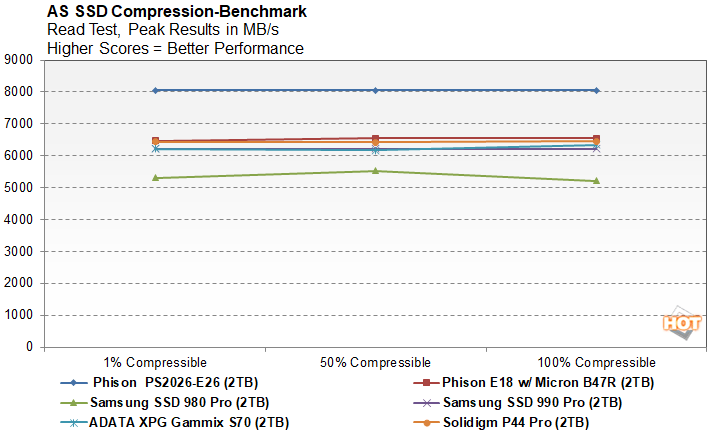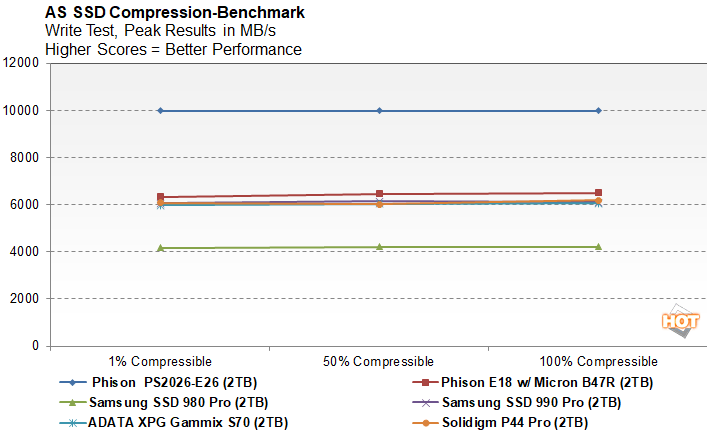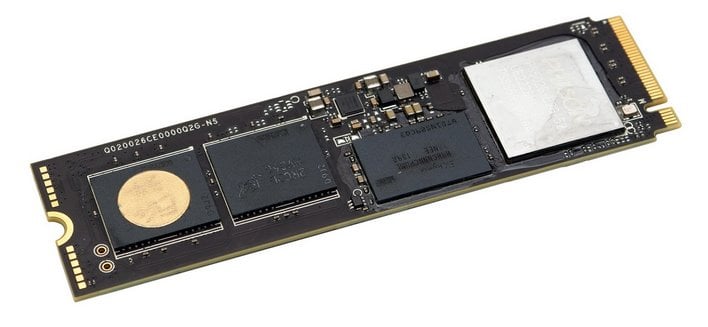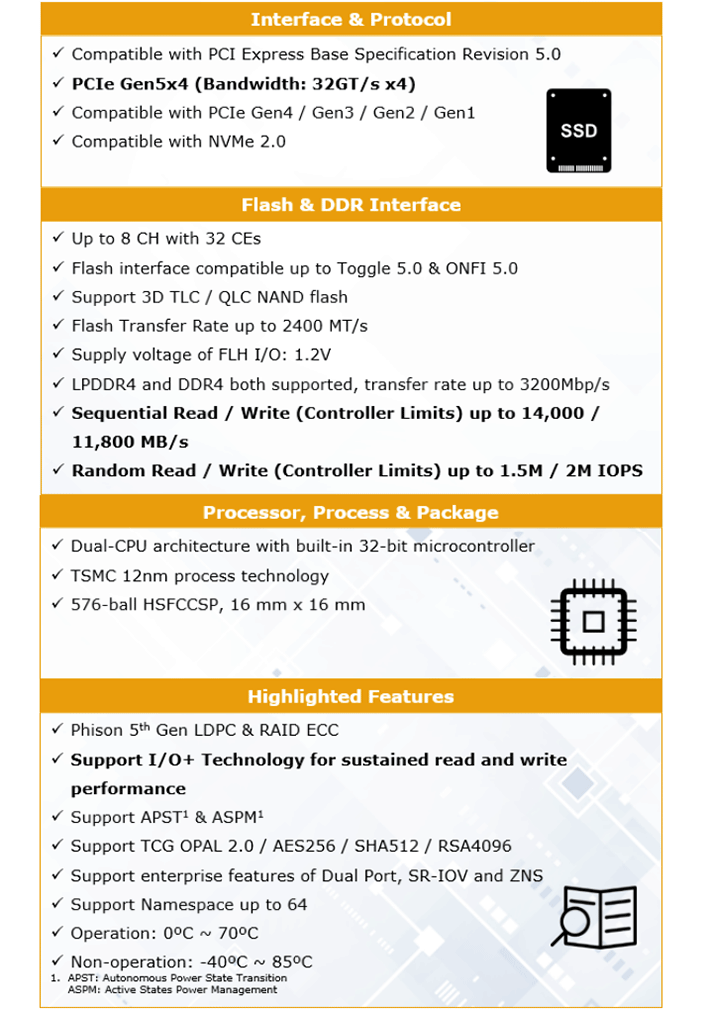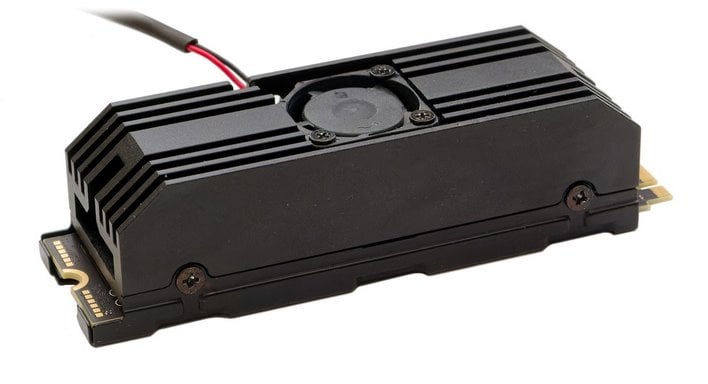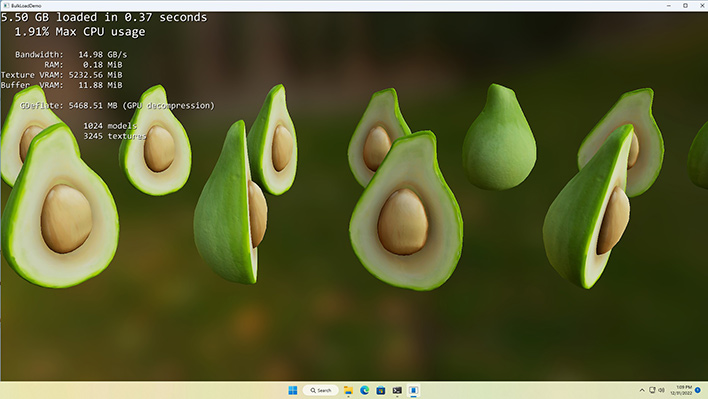Phison E26 SSD Preview: PCIe 5 Storage Breaks Out For 2023
Phison E26 SSD Preview: Next-Gen PCIe 5 Storage Performance Explored
| Phison E26 PCIe 5 NVMe SSD Preview: Coming Soon To An SSD Near You A new controller, fresh firmware, and an updated design paradigm results in one of the fastest SSDs we've ever tested.
|
|||

|

|
||
Phison E26 PCIe 5 NVMe SSD Specifications And Features
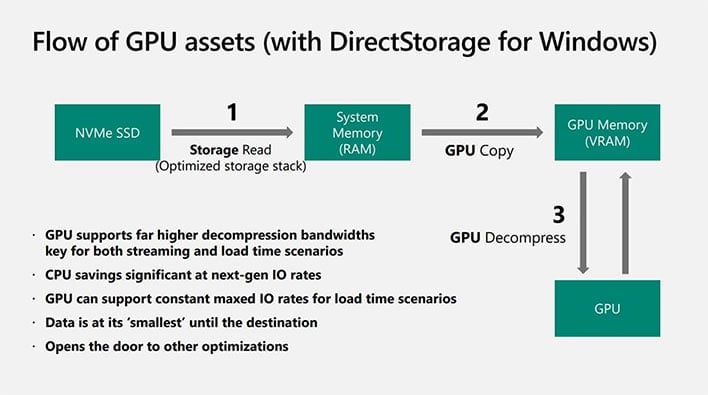
We did some quick tests with a simulated DirectStorage workload on the E26 and the results are presented here. Effective bandwidth peaked at just shy of 15GB/s and 5.5GB of data loaded in about 1/3 of a second. Note, this tests was performed with a GeForce RTX 3080. With a higher-performing GPU, the GPU decompression data rate would have increased and effected the results.
Phison E26 PCIe 5 NVMe SSD Benchmarks
Under each test condition, the SSDs showcased here were installed as secondary volumes in our testbed, with a separate drive used for the OS and benchmark installations. Our testbed's motherboard was updated with the latest BIOS available at the time of publication and Windows 11 was fully updated. Windows firewall, automatic updates, and screen savers were all disabled before testing and Focus Assist was enabled to prevent any interruptions.
In all test runs, we rebooted the system, ensured all temp and prefetch data was purged, and waited several minutes for drive activity to settle and for the system to reach an idle state before invoking a test. All of the drives here have also been updated to their latest firmware as of press time. Where applicable, we would also typically use any proprietary NVMe drivers available from a given manufacturer, but all of the drives featured here used the Microsoft NVMe driver included with Windows 11.HotHardware's Test System:
| Processor: AMD Ryzen 9 7950X Motherboard: Asus ROG CrossHair X670E Hero Video Card: GeForce RTX 3080 Memory: 32GB G.SKILL DDR5-5200 Storage: ADATA XPG GAMMIX S70 Blade (OS Drive) ADATA XPG GAMMIX S70 (2TB) Phison E18 B47R (2TB) Samsung SSD 980 Pro (2TB) Samsung SSD 990 Pro (2TB) Solidigm P44 Pro (2TB) Phison E26 Prototype (2TB) |
OS: Windows 11 Pro x64 Chipset Drivers: AMD v4.11.15.342 Benchmarks: IOMeter 1.1 HD Tune v5.75 ATTO v4.01.01f AS SSD SiSoftware SANDRA CrystalDiskMark v8.0.4 x64 Final Fantasy XIV: Endwalker PCMark 10 Quick Storage Bench 3DMark Storage Tests |
IOMeter Benchmarks
IOMeter is a well-respected industry standard benchmark. However, despite our results with IOMeter scaling as expected, it is debatable as to whether or not certain access patterns actually provide a valid example of real-world performance. The access patterns we tested may not reflect your particular workloads, for example. That said, we do think IOMeter is a reliable gauge for relative throughput, latency, and bandwidth with a given storage solution. In addition, there are certain highly-strenuous workloads you can place on a drive with IOMeter that you simply can't with most other storage benchmark tools.In the following tables, we're showing two sets of access patterns; a custom Workstation pattern, with an 8K transfer size, consisting of 80% reads (20% writes) and 80% random (20% sequential) access and a 4K access pattern with a 4K transfer size, comprised of 67% reads (33% writes) and 100% random access. Queue depths from 1 to 16 were tested.
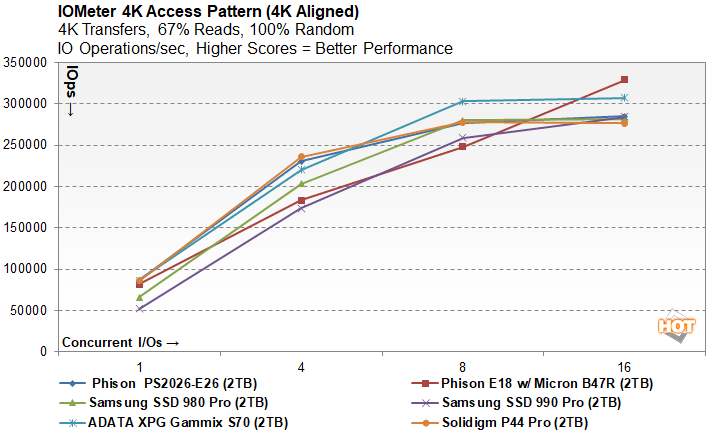
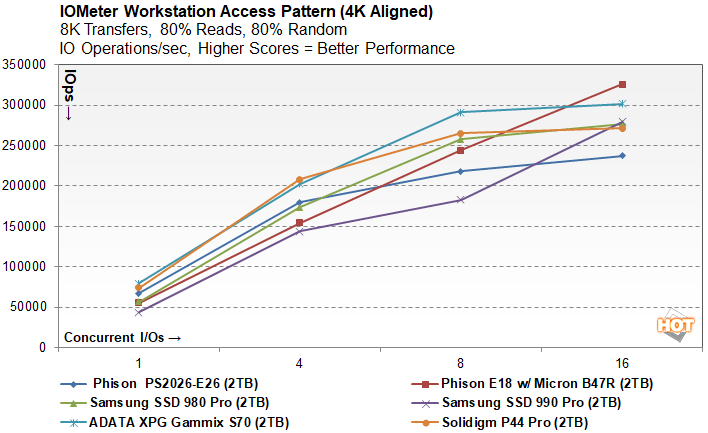
The main advantage this Phison reference platform has over the other SSDs in this benchmark is its PCIe 5.0 interface. That really doesn't help it in this 8K transfer workstation benchmark, where it ultimately ends up trailing at the higher queue depth. Still, it's important to keep in mind that these are some of the very fastest SSDs on the market, and none of the drives here actually perform "poorly" in an absolute sense. Notably, in the all-important QD1 and QD4 tests, it lands right in the middle of this esteemed pack.
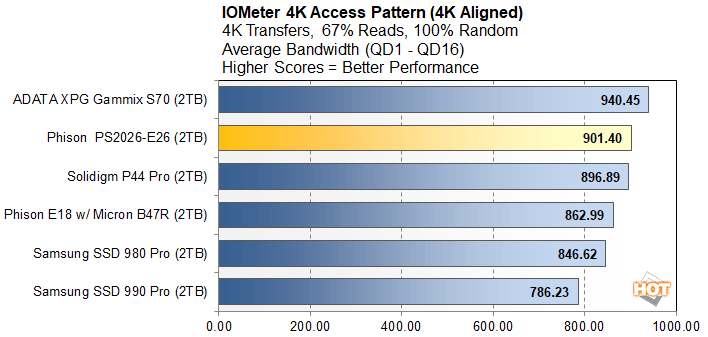
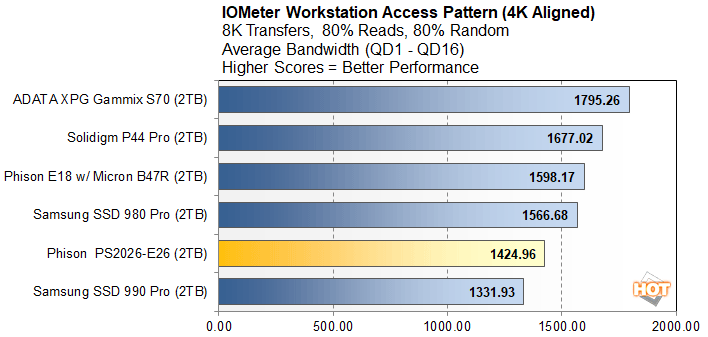
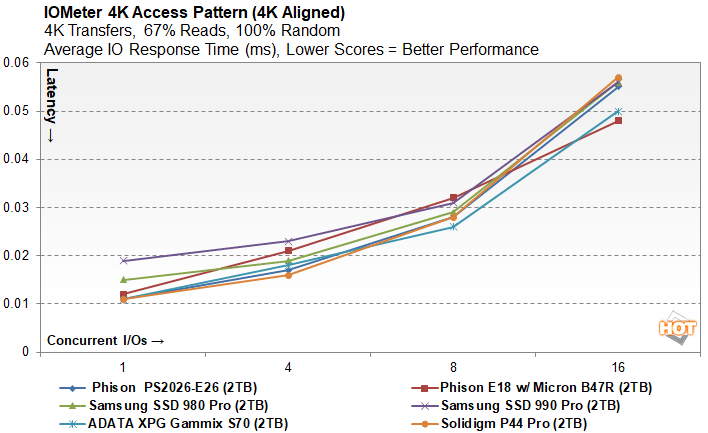
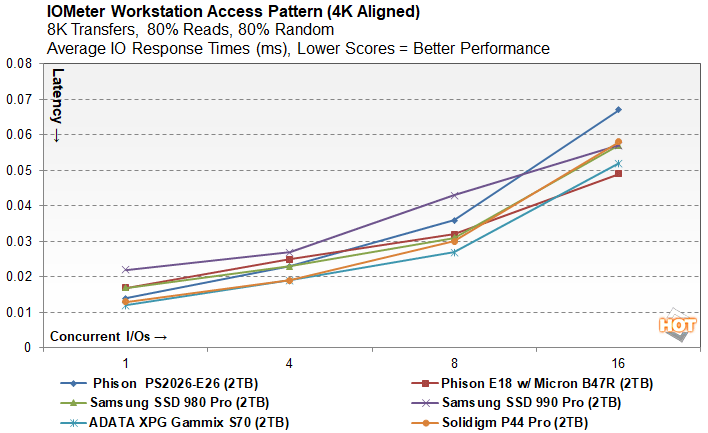
In these latency tests, the Phison reference platform and its E26 controller impress at 4K but once again falter a bit in the Workstation pattern. Clearly, this drive and its controller are tuned for client desktop usage and less for heavy workstation access patterns.
SiSoft SANDRA 2021
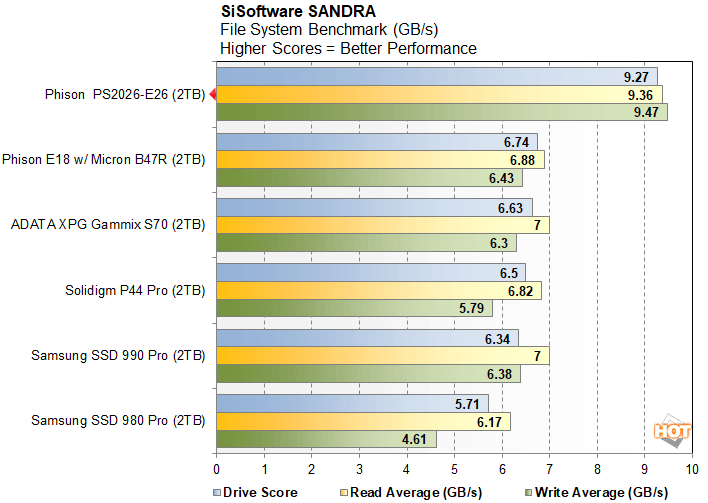
ATTO Disk Benchmark
ATTO is another "quick and dirty" type of disk benchmark that measures transfer speeds across a specific volume length. It measures raw transfer rates for both reads and writes and graphs them out in an easily interpreted chart. We chose .5KB through 64MB transfer sizes and a queue depth of 6 over a total max volume length of 256MB. ATTO's workloads are sequential in nature and measure raw bandwidth, rather than I/O response time, access latency, etc.
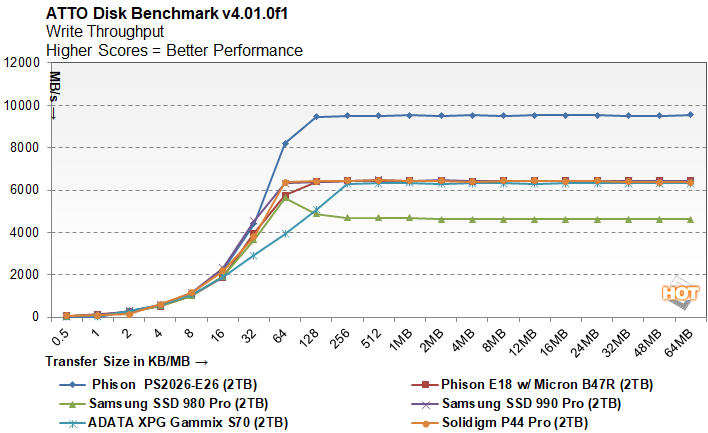

In these sequential tests, we once again see the PCIe 5.0 Phison drive completely outpace the competition. The rest of the drives, limited by their PCIe 4.0 interfaces as they are, cluster up around 7 GB/sec after the 1MB transfer size, although the E26 is creeping ahead in reads as early as 32KB. Meanwhile the Phison drive peaks at over 9 GB/second in both reads and writes.

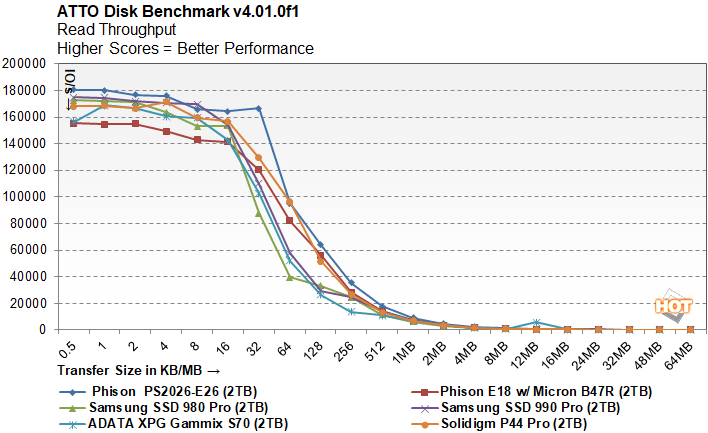
These benchmarks measure IOPS instead of transfer rate, so naturally the numerical performance of the drive falls off a cliff as transfer size rises. The Phison drive manages to lead the pack in read IOPS at every transfer size, but it clearly struggles a bit with write performance with very small transfer sizes. This might be a firmware optimization for Phison to work out, or it could simply be an oddity of ATTO's test.
AS SSD Compression Benchmark
Next up we ran the Compression Benchmark built-into AS SSD, an SSD specific benchmark being developed by Alex Intelligent Software. This test is interesting because it uses a mix of compressible and non-compressible data and outputs both Read and Write throughput of the drive. We only graphed a small fraction of the data (1% compressible, 50% compressible, and 100% compressible), but the trend is representative of the benchmark’s complete results.
